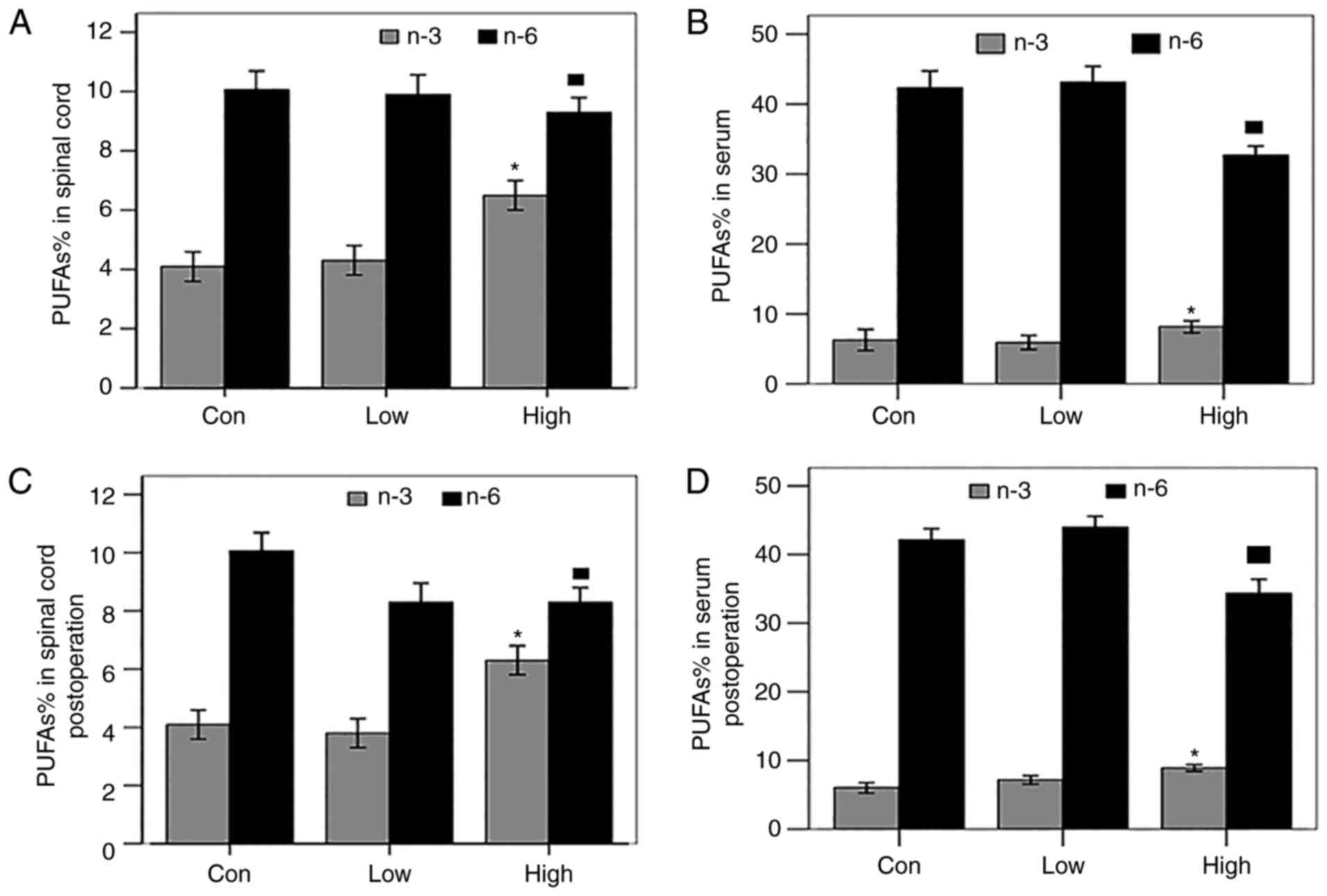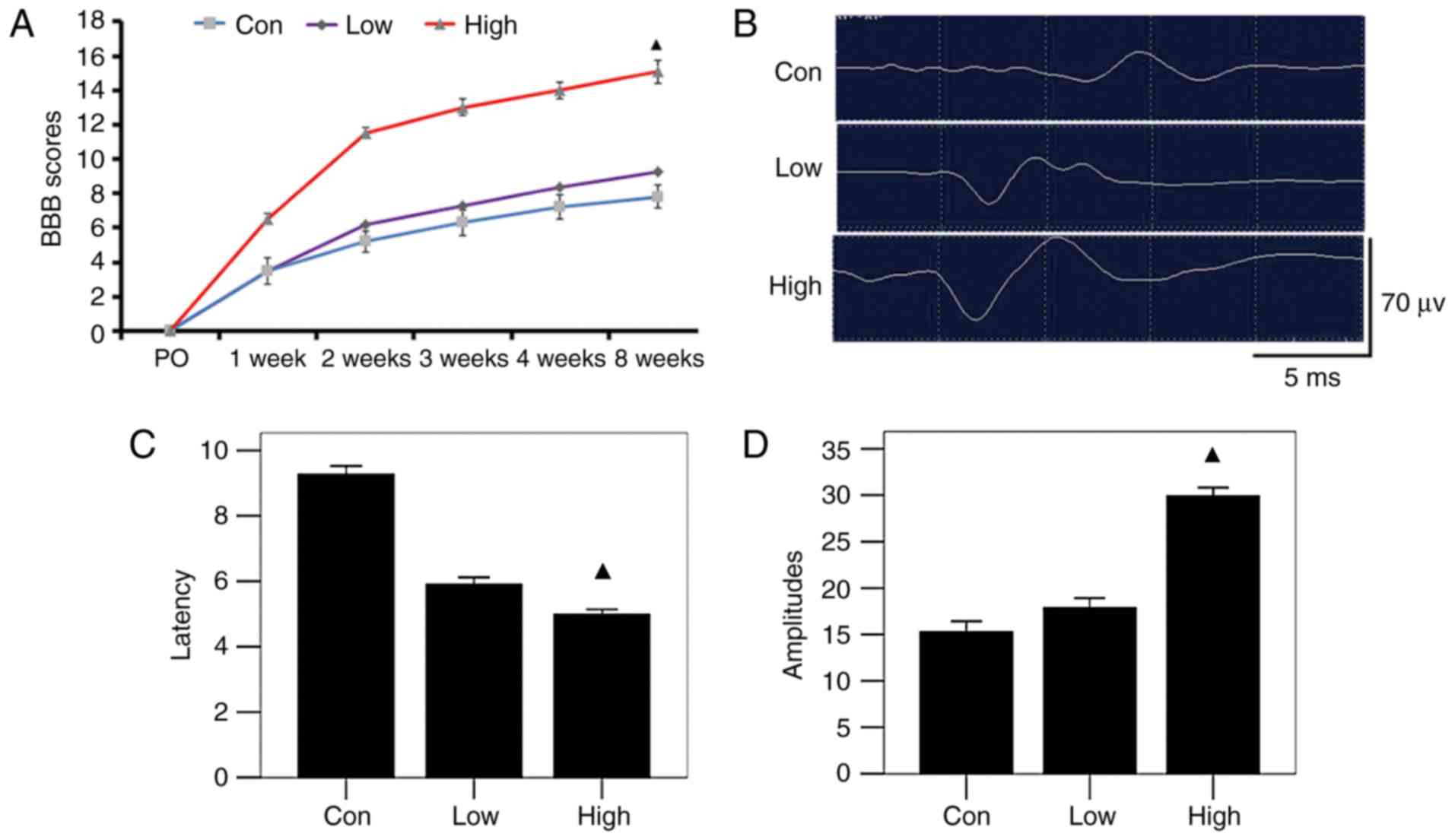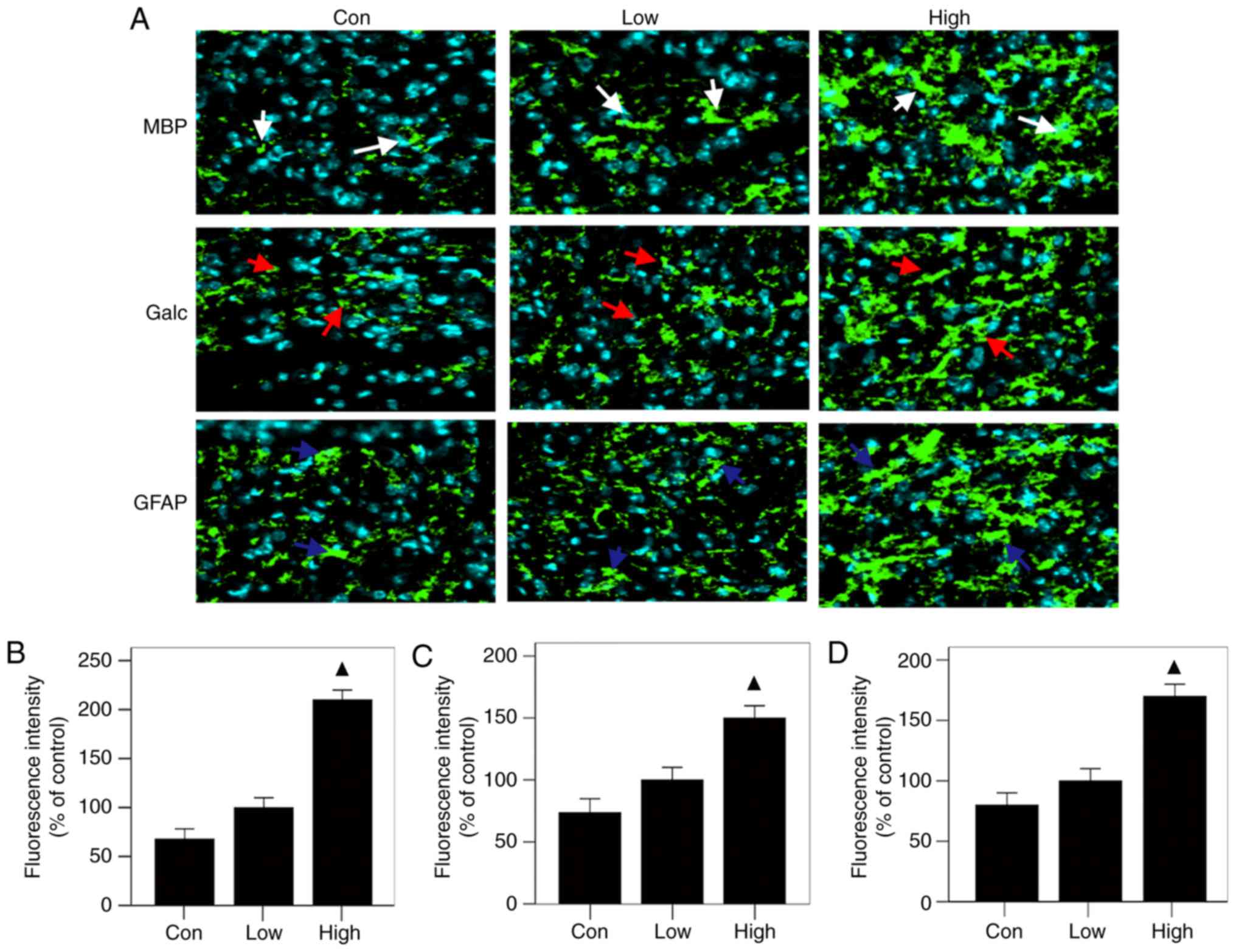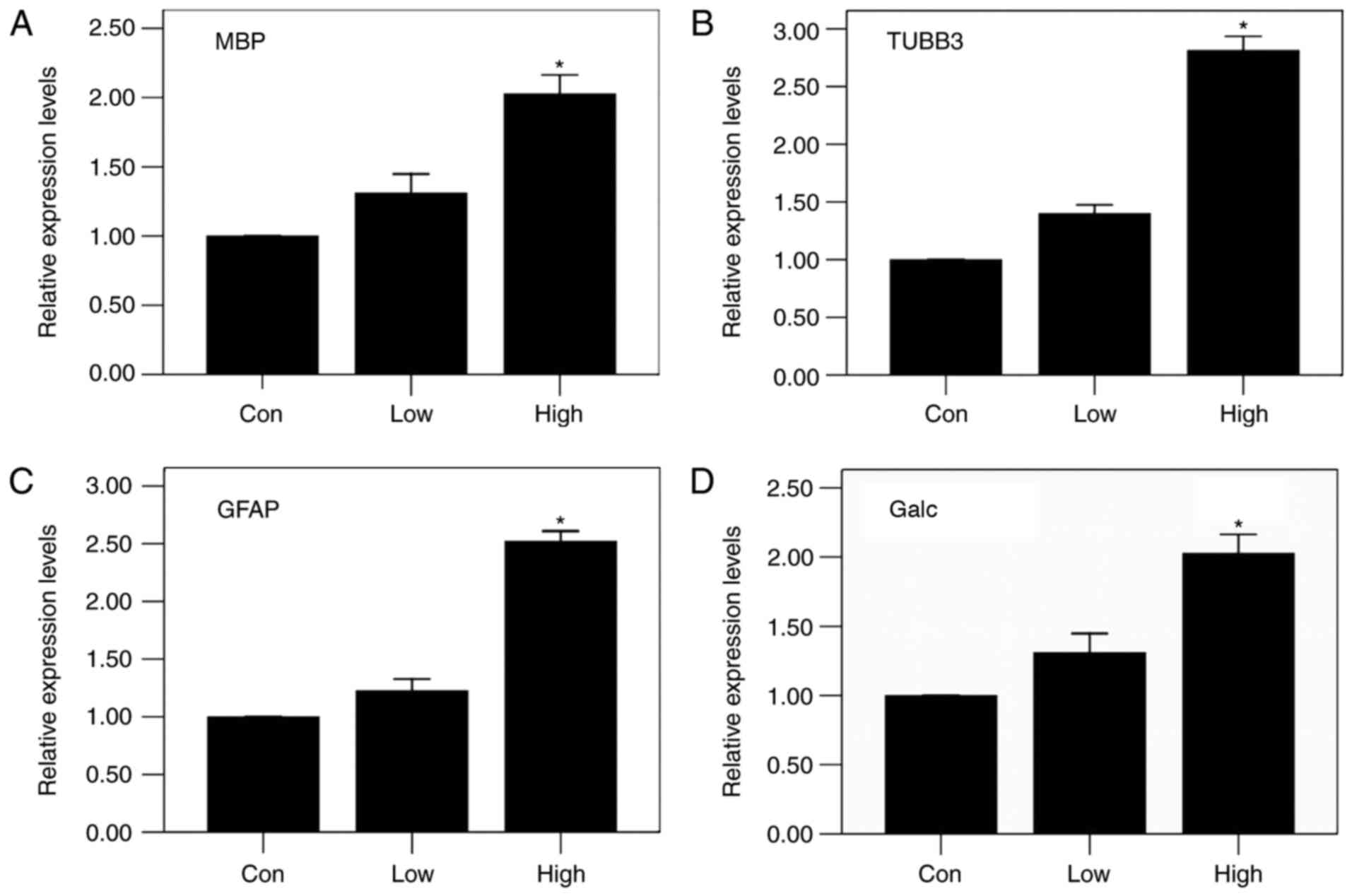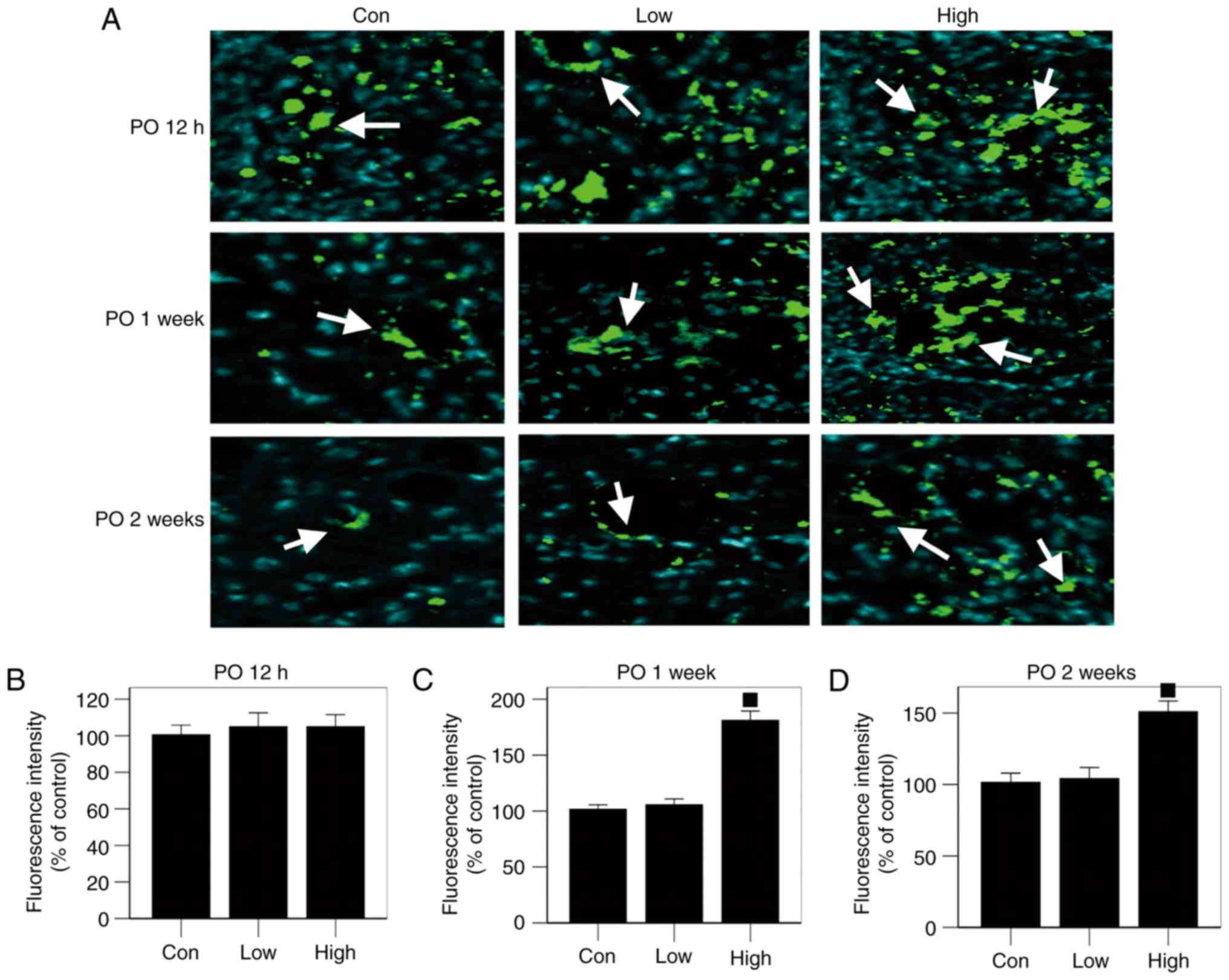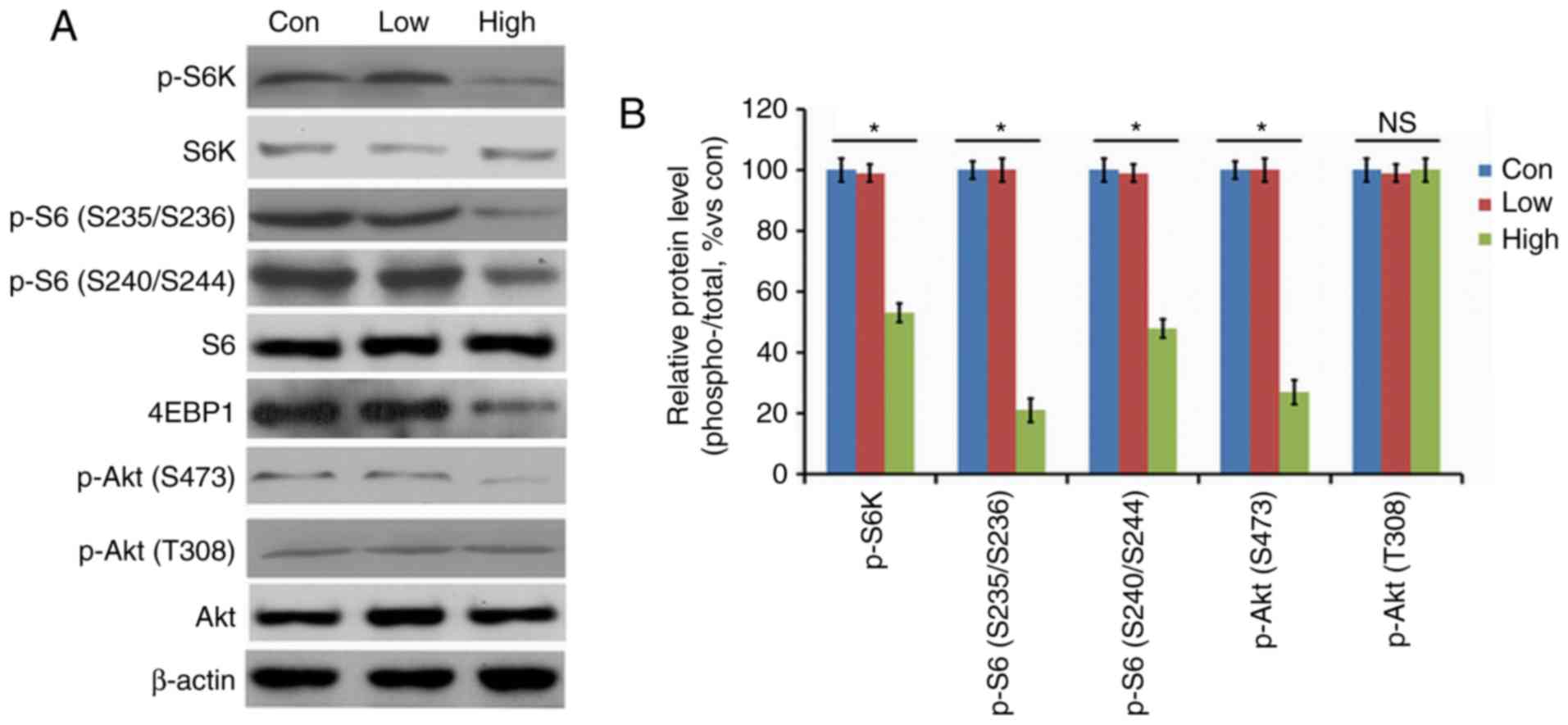|
1
|
Schwab ME: Regenerative nerve fiber in the
adult central nervous system. News Physiol Sci. 13:294–298.
1998.PubMed/NCBI
|
|
2
|
Fry EJ: Central nervous system
regeneration: Mission impossible? Clin Exp Pharmacol Physiol.
28:253–258. 2001. View Article : Google Scholar : PubMed/NCBI
|
|
3
|
Ritfeld GJ, Nandoe Tewarie RD, Vajn K,
Rahiem ST, Hurtado A, Wendell DF, Roos RA and Oudega M: Bone marrow
stromal cell-mediated tissue sparing enhances functional repair
after spinal cord contusion in adult rats. Cell Transplant.
21:1561–1575. 2012. View Article : Google Scholar : PubMed/NCBI
|
|
4
|
Ribatti D, Conconi MT, Nico B, Baiguera S,
Corsi P, Parnigotto PP and Nussdorfer GG: Angiogenic response
induced by acellular brain scaffolds grafted onto the chick embryo
chorioallantoic membrane. Brain Res. 989:9–15. 2003. View Article : Google Scholar : PubMed/NCBI
|
|
5
|
Johnson PJ, Tatara A, Shiu A and
Sakiyama-Elbert SE: Controlled release of neurotrophin-3 and
platelet-derived growth factor from fibrin scaffolds containing
neural progenitor cells enhances survival and differentiation into
neurons in a subacute model of SCI. Cell Transplant. 19:89–101.
2011. View Article : Google Scholar
|
|
6
|
Zurita M, Vaquero J, Oya S and Miguel M:
Schwann cells induce neuronal differentiation of bone marrow
stromal cells. Neuroreport. 16:505–508. 2005. View Article : Google Scholar : PubMed/NCBI
|
|
7
|
Liu GM, Luo YG, Li J and Xu K: Knockdown
of Nogo gene by short hairpin RNA interference promotes functional
recovery of spinal cord injury in a rat model. Mol Med Rep.
13:4431–4436. 2016. View Article : Google Scholar : PubMed/NCBI
|
|
8
|
Guo J and Li Y, Chen Z, He Z, Zhang B and
Li Y, Hu J, Han M, Xu Y and Li Y: N-acetylcysteine treatment
following spinal cord trauma reduces neural tissue damage and
improves locomotor function in mice. Mol Med Rep. 12:37–44. 2015.
View Article : Google Scholar : PubMed/NCBI
|
|
9
|
Chen KB, Uchida K, Nakajima H, Yayama T,
Hirai T, Watanabe S, Guerrero AR, Kobayashi S, Ma WY, Liu SY and
Baba H: Tumor necrosis factor-α antagonist reduces apoptosis of
neurons and oligodendroglia in rat spinal cord injury. Spine (Phila
Pa 1976). 36:1350–1358. 2011. View Article : Google Scholar : PubMed/NCBI
|
|
10
|
Figueroa JD and De Leon M:
Neurorestorative targets of dietary long-chain omega-3 fatty acids
in neurological injury. Mol Neurobiol. 50:197–213. 2014. View Article : Google Scholar : PubMed/NCBI
|
|
11
|
Zeman M, Jirak R, Vecka M, Raboch J and
Zak A: N-3 polyunsaturated fatty acids in psychiatric diseases:
Mechanisms and clinical data. Neuro Endocrinol Lett. 33:736–748.
2012.PubMed/NCBI
|
|
12
|
Hasadsri L, Wang BH, Lee JV, Erdman JW,
Llano DA, Barbey AK, Wszalek T, Sharrock MF and Wang HJ: Omega-3
fatty acids as a putative treatment for traumatic brain injury. J
Neurotrauma. 30:897–906. 2013. View Article : Google Scholar : PubMed/NCBI
|
|
13
|
Huang MJ, Wang L, Jin DD, Zhang ZM, Chen
TY, Jia CH, Wang Y, Zhen XC, Huang B, Yan B, et al: Enhancement of
the synthesis of n-3 PUFAs in fat-1 transgenic mice inhibits mTORC1
signalling and delays surgically induced osteoarthritis in
comparison with wild-type mice. Ann Rheum Dis. 73:1719–1727. 2014.
View Article : Google Scholar : PubMed/NCBI
|
|
14
|
Lim SN, Gladman SJ, Dyall SC, Patel U,
Virani N, Kang JX, Priestley JV and Michael-Titus AT: Transgenic
mice with high endogenous omega-3 fatty acids are protected from
spinal cord injury. Neurobiol Dis. 51:104–112. 2013. View Article : Google Scholar : PubMed/NCBI
|
|
15
|
Wen ZH, Su YC, Lai PL, Zhang Y, Xu YF,
Zhao A, Yao GY, Jia CH, Lin J, Xu S, et al: Critical role of
arachidonic acid activated mTOR signaling in breast carcinogenesis
and angiogenesis. Oncogene. 32:160–170. 2013. View Article : Google Scholar : PubMed/NCBI
|
|
16
|
Gerber M: Omega-3 fatty acids and cancers:
A systematic update review of epidemiological studies. Br J Nutr.
107 Suppl 2:S228–S239. 2012. View Article : Google Scholar : PubMed/NCBI
|
|
17
|
Fleming JC, Norenberg MD, Ramsay DA,
Dekaban GA, Marcillo AE, Saenz AD, Pasquale-Styles M, Dietrich WD
and Weaver LC: The cellular inflammatory response in human spinal
cords after injury. Brain. 129:3249–3269. 2006. View Article : Google Scholar : PubMed/NCBI
|
|
18
|
Donnelly DJ and Popovich PG: Inflammation
and its role in neuroprotection, axonal regeneration and functional
recovery after spinal cord injury. Exp Neurol. 209:378–388. 2008.
View Article : Google Scholar : PubMed/NCBI
|
|
19
|
Daniel J and Klionsky: The molecular
machinery of autophagy: unanswered questions. J Cell Sci. 118:7–18.
2005. View Article : Google Scholar : PubMed/NCBI
|
|
20
|
Kanki T and Klionsky DJ: The molecular
mechanism of mitochondria autophagy in yeast. Mol Microbiol.
75:795–800. 2010. View Article : Google Scholar : PubMed/NCBI
|
|
21
|
Kanno H, Ozawa H, Sekiguchi A, Yamaya S,
Tateda S, Yahata K and Itoi E: The role of mTOR signaling pathway
in spinal cord injury. Cell Cycle. 11:3175–3179. 2012. View Article : Google Scholar : PubMed/NCBI
|
|
22
|
Liu K, Lu Y, Lee JK, Samara R, Willenberg
R, Sears-Kraxberger I, Tedeschi A, Park KK, Jin D, Cai B, et al:
PTEN deletion enhances the regenerative ability of adult
corticospinal neurons. Nat Neurosci. 13:1075–10781. 2010.
View Article : Google Scholar : PubMed/NCBI
|
|
23
|
Lamming DW and Sabatini DM: A central role
for mTOR in lipid homeostasis. Cell Metab. 18:465–469. 2013.
View Article : Google Scholar : PubMed/NCBI
|
|
24
|
Laplante M and Sabatini DM: An emerging
role of mTOR in lipid biosynthesis. Curr Biol. 19:R1046–R1052.
2009. View Article : Google Scholar : PubMed/NCBI
|
|
25
|
Laplante M and Sabatini DM: mTOR signaling
at a glance. J Cell Sci. 122:3589–3594. 2009. View Article : Google Scholar : PubMed/NCBI
|
|
26
|
Laplante M and Sabatini DM: mTOR
signaling. Cold Spring Harb Perspect Biol. 4(pii):
a0115932012.PubMed/NCBI
|
|
27
|
Su M, Guan H, Zhang F, Gao Y, Teng X and
Yang W: HDAC6 regulates the chaperone-mediated autophagy to prevent
oxidative damage in injured neurons after experimental spinal cord
injury. Oxid Med Cell Longev. 2016:72637362016. View Article : Google Scholar : PubMed/NCBI
|
|
28
|
Zhou KL, Zhou YF, Wu K, Tian NF, Wu YS,
Wang YL, Chen DH, Zhou B, Wang XY, Xu HZ and Zhang XL: Stimulation
of autophagy promotes functional recovery in diabetic rats with
spinal cord injury. Sci Rep. 5:171302015. View Article : Google Scholar : PubMed/NCBI
|
|
29
|
Zhou Y, Zheng B, Ye L, Zhang H, Zhu S,
Zheng X, Xia Q, He Z, Wang Q, Xiao J and Xu H: Retinoic acid
prevents disruption of blood-spinal cord barrier by inducing
autophagic flux after spinal cord injury. Neurochem Res.
41:813–825. 2016. View Article : Google Scholar : PubMed/NCBI
|
|
30
|
Gao K, Wang G, Wang Y, Han D, Bi J, Yuan
Y, Yao T, Wan Z, Li H and Mei X: Neuroprotective effect of
simvastatin via inducing the autophagy on spinal cord injury in the
rat model. Biomed Res Int. 2015:2601612015. View Article : Google Scholar : PubMed/NCBI
|
|
31
|
Guo Y, Liu S, Zhang X, Wang L, Gao J, Han
A and Hao A: G-CSF promotes autophagy and reduces neural tissue
damage after spinal cord injury in mice. Lab Invest. 95:1439–1449.
2015. View Article : Google Scholar : PubMed/NCBI
|
|
32
|
Lotz MK and Caramés B: Autophagy and
cartilage homeostasis mechanisms in joint health, aging and OA. Nat
Rev Rheumatol. 7:579–587. 2011. View Article : Google Scholar : PubMed/NCBI
|
|
33
|
Kanno H, Ozawa H, Sekiguchi A, Yamaya S
and Itoi E: Induction of autophagy and autophagic cell death in
damaged neural tissue after acute spinal cord injury in mice. Spine
(Phila Pa 1976). 36:E1427–E1434. 2011. View Article : Google Scholar : PubMed/NCBI
|
|
34
|
Basso DM, Beattie MS and Bresnahan JC: A
sensitive and reliable locomotor rating scale for open field
testing in rats. J Neurotrauma. 12:1–21. 1995. View Article : Google Scholar : PubMed/NCBI
|
|
35
|
Zhang XY, Xue H, Liu JM and Chen D:
Chemically extracted acellular muscle: A new potential scaffold for
spinal cord injury repair. J Biomed Mater Res A. 100:578–587. 2012.
View Article : Google Scholar : PubMed/NCBI
|
|
36
|
Wei D, Li J, Shen M, Jia W, Chen N, Chen
T, Su D, Tian H, Zheng S, Dai Y and Zhao A: Cellular production of
n-3 PUFAs and reduction of n-6-to-n-3 ratios in the pancreatic
beta-cells and islets enhance insulin secretion and confer
protection against cytokine-induced cell death. Diabetes.
59:471–478. 2010. View Article : Google Scholar : PubMed/NCBI
|
|
37
|
Kang JX: A transgenic mouse model for
gene-nutrient interactions. J Nutrigenet Nutrigenomics. 1:172–177.
2008. View Article : Google Scholar : PubMed/NCBI
|
|
38
|
Nakamura M, Houghtling RA, MacArthur L,
Bayer BM and Bregman BS: Differences in cytokine gene expression
profile between acute and secondary injury in adult rat spinal
cord. Exp Neurol. 184:313–325. 2003. View Article : Google Scholar : PubMed/NCBI
|
|
39
|
Manku MS, Horrobin DF, Huang YS and Morse
N: Fatty acids in plasma and red cell membranes in normal humans.
Lipids. 18:906–908. 1983. View Article : Google Scholar : PubMed/NCBI
|
|
40
|
Dyall SC, Michael GJ, Whelpton R, Scott AG
and Michael-Titus AT: Dietary enrichment with omega-3
polyunsaturated fatty acids reverses age-related decreases in the
GluR2 and NR2B glutamate receptor subunits in rat forebrain.
Neurobiol Aging. 28:424–439. 2007. View Article : Google Scholar : PubMed/NCBI
|
|
41
|
Jiang W, Zhu Z, McGinley JN, El Bayoumy K,
Manni A and Thompson HJ: Identification of a molecular signature
underlying inhibition of mammary carcinoma growth by dietary n-3
fatty acids. Cancer Res. 72:3795–3806. 2012. View Article : Google Scholar : PubMed/NCBI
|
|
42
|
Chen Z, Zhang Y, Jia C, Wang Y, Lai P,
Zhou X, Wang Y, Song Q, Lin J, Ren Z, et al: mTORC1/2 targeted by
n-3 polyunsaturated fatty acids in the prevention of mammary
tumorigenesis and tumor progression. Oncogene. 33:4548–4557. 2014.
View Article : Google Scholar : PubMed/NCBI
|
|
43
|
Berquin IM, Edwards IJ and Chen YQ:
Multi-targeted therapy of cancer by omega-3 fatty acids. Cancer
Lett. 269:363–377. 2008. View Article : Google Scholar : PubMed/NCBI
|
|
44
|
Larsson SC, Kumlin M, Ingelman-Sundberg M
and Wolk A: Dietary long-chain n-3 fatty acids for the prevention
of cancer: A review of potential mechanisms. Am J Clin Nutr.
79:935–945. 2004. View Article : Google Scholar : PubMed/NCBI
|
|
45
|
Streit WJ, Semple-Rowland SL, Hurley SD,
Miller RC, Popovich PG and Stokes BT: Cytokine mRNA profiles in
contused spinal cord and axotomized facial nucleus suggest a
beneficial role for inflammation and gliosis. Exp Neurol.
152:74–87. 1998. View Article : Google Scholar : PubMed/NCBI
|
|
46
|
Bracken MB, Shepard MJ, Collins WF,
Holford TR, Young W, Baskin DS, Eisenberg HM, Flamm E, Leo-Summers
L, Maroon J, et al: A randomized, controlled trial of
methylprednisolone or naloxone in the treatment of acute
spinal-cord injury. Results of the second national acute spinal
cord injury study. N Engl J Med. 322:1405–1411. 1990. View Article : Google Scholar : PubMed/NCBI
|
|
47
|
Wang CX, Olschowka JA and Wrathall JR:
Increase of interleukin-1beta mRNA and protein in the spinal cord
following experimental traumatic injury in the rat. Brain Res.
13:190–196. 1997. View Article : Google Scholar
|
|
48
|
Lu Y, Jiang BC, Cao DL, Zhang ZJ, Zhang X,
Ji RR and Gao YJ: TRAF6 upregulation in spinal astrocytes maintains
neuropathic pain by integrating TNF-α and IL-1β signaling. Pain.
155:2618–2629. 2014. View Article : Google Scholar : PubMed/NCBI
|
|
49
|
Grau JW, Huie JR, Lee KH, Hoy KC, Huang
YJ, Turtle JD, Strain MM, Baumbauer KM, Miranda RM, Hook MA, et al:
Metaplasticity and behavior: How training and inflammation affect
plastic potential within the spinal cord and recovery after injury.
Front Neural Circuits. 8:1002014. View Article : Google Scholar : PubMed/NCBI
|
|
50
|
Erlich S, Alexandrovich A, Shohami E and
Pinkas-Kramarski R: Rapamycin is a neuroprotective treatment for
traumatic brain injury. Neurobiol Dis. 26:86–93. 2007. View Article : Google Scholar : PubMed/NCBI
|
|
51
|
Hou H, Zhang L, Zhang L and Tang P: Acute
spinal cord injury in rats should target activated autophagy. J
Neurosurg Spine. 20:568–577. 2014. View Article : Google Scholar : PubMed/NCBI
|
|
52
|
Hao HH, Wang L, Guo ZJ, Bai L, Zhang RP,
Shuang WB, Jia YJ, Wang J, Li XY and Liu Q: Valproic acid reduces
autophagy and promotes functional recovery after spinal cord injury
in rats. Neurosci Bull. 29:484–492. 2013. View Article : Google Scholar : PubMed/NCBI
|
|
53
|
Wang ZY, Lin JH, Muharram A and Liu WG:
Beclin-1-mediated autophagy protects spinal cord neurons against
mechanical injury-induced apoptosis. Apoptosis. 19:933–945. 2014.
View Article : Google Scholar : PubMed/NCBI
|
|
54
|
Serhan CN, Dalli J, Colas RA, Winkler JW
and Chiang N: Protectins and maresins: New pro-resolving families
of mediators in acute inflammation and resolution bioactive
metabolome. Biochim Biophys Acta. 1851:397–413. 2015. View Article : Google Scholar : PubMed/NCBI
|
|
55
|
Chen Z, Fu Q, Shen B, Huang X, Wang K, He
P, Li F, Zhang F and Shen H: Enhanced p62 expression triggers
concomitant autophagy and apoptosis in a rat chronic spinal cord
compression model. Mol Med Rep. 9:2091–2096. 2014. View Article : Google Scholar : PubMed/NCBI
|




